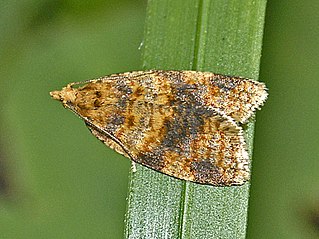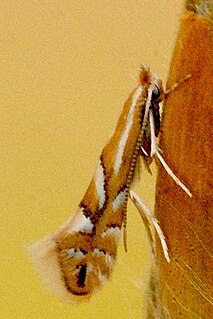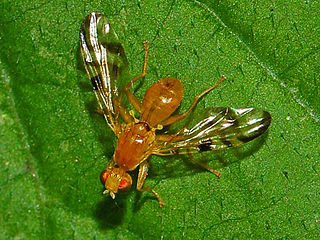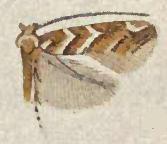
A leaf miner is any one of numerous species of insects in which the larval stage lives in, and eats, the leaf tissue of plants. The vast majority of leaf-mining insects are moths (Lepidoptera), sawflies, and flies (Diptera). Some beetles also exhibit this behavior.

Dyseriocrania subpurpurella is a diurnal moth from the family Eriocraniidae, found in most of Europe. The moth was first named by the English entomologist, Adrian Hardy Haworth in 1828.

Andricus foecundatrix is a parthenogenetic gall wasp which lays a single egg within a leaf bud, using its ovipositor, to produce a gall known as an oak artichoke gall, oak hop gall, larch-cone gall or hop strobile The gall develops as a chemically induced distortion of leaf axillary or terminal buds on pedunculate oak or sessile oak trees. The larva lives inside a smaller hard casing inside the artichoke and this is released in autumn. The asexual wasp emerges in spring and lays her eggs in the oak catkins. These develop into small oval galls which produce the sexual generation of wasps. A yew artichoke gall caused by the fly Taxomyia taxi also exists, but is unrelated to the oak-borne species. Previous names or synonyms for the species A. fecundator are A. fecundatrix, A. pilosus, A. foecundatrix, A. gemmarum, A. gemmae, A. gemmaequercus, A. gemmaecinaraeformis and A. quercusgemmae.

Epagoge grotiana, common name brown-barred tortrix, is a moth of the family Tortricidae, first described by Johan Christian Fabricius in 1781.

Phyllonorycter maestingella is a moth of the family Gracillariidae. It is found in Europe, Russia and British Columbia, Canada.

Acidia cognata is a species of fly in the family Tephritidae.

Dyseriocrania griseocapitella is a moth of the family Eriocraniidae. It is found from Nova Scotia to Florida, west to Illinois and Mississippi.

Elachista gleichenella is a moth of the family Elachistidae found in most of Europe.

Phyllonorycter heegeriella is a moth of the family Gracillariidae. It is found in all of Europe, except the Iberian Peninsula and the Balkan Peninsula.

Phyllonorycter roboris is a moth of the family Gracillariidae. It is found in all of Europe.

The European oak leaf-miner or Zeller's midget is a moth of the family Gracillariidae. It is found in Europe south of the line running from Ireland, through Great Britain, Denmark to Ukraine. It is also found in Macaronesia. It is an introduced species in New Zealand and Australia.

The solitary oak leafminer is a moth of the family Gracillariidae. It is widely distributed in temperate North America.

Cameraria cincinnatiella is a moth of the family Gracillariidae. It is known from Ontario and Quebec in Canada, and the United States.
Caloptilia alnivorella, the alder leafminer, is a moth of the family Gracillariidae. The species was first described by Vactor Tousey Chambers in 1875. It is known from the Russian Far East, Canada and the United States.
Dyseriocrania auricyanea is a moth of the family Eriocraniidae. It was first described by Baron Walsingham in 1882 and is found in California.

Trypeta zoe, the daisy leafminer, is a species of tephritid or fruit flies in the genus Trypeta of the family Tephritidae.

Orchestes fagi , beech leaf-miner beetle, is a species of weevil native to Europe. The larvae mine the leaves of beech. It is an invasive species in Canada where it is damaging to American beech.

Profenusa thomsoni, the amber-marked birch leaf miner, is a species of sawfly in the family Tenthredinidae. It is native to the Palearctic realm but has spread to North America. The larvae feed on the foliage of birch trees.
This page is based on this
Wikipedia article Text is available under the
CC BY-SA 4.0 license; additional terms may apply.
Images, videos and audio are available under their respective licenses.













